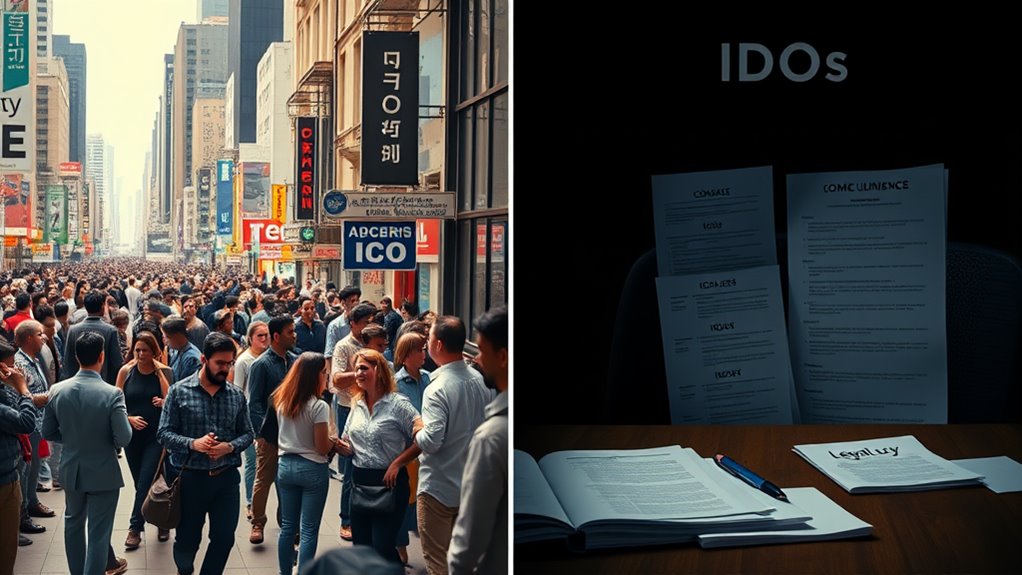
ICOs and IDOs Are Regulated: How They Differ in Oversight and Compliance Risks
ICOs and IDOs differ considerably in regulatory oversight and compliance risks. ICOs face stringent regulations with thorough KYC procedures and securities classification in many jurisdictions, resulting in higher compliance costs. IDOs emphasize decentralization with minimal oversight, distributing compliance burdens across platforms while utilizing smart contracts for security. Geographic variations complicate operations, with countries like Switzerland offering token-friendly environments while China imposes outright bans. The evolving regulatory landscape continues to shape best practices for both fundraising methods.
Key Takeaways
- ICOs face stringent securities regulations while IDOs operate with minimal oversight due to their decentralized nature.
- ICO issuers bear full regulatory responsibility, whereas IDOs distribute compliance burdens across platform participants.
- KYC implementation is typically thorough in ICOs but often streamlined or absent in IDOs, creating different investor verification standards.
- Global regulatory fragmentation creates compliance complexity, with countries ranging from token-friendly environments to outright bans.
- ICOs rely on centralized security measures, while IDOs leverage automated smart contracts that may contain vulnerabilities requiring audits.
The Evolving Regulatory Landscape of Token Offerings

As the cryptocurrency market continues to mature, regulatory frameworks for Initial Coin Offerings (ICOs) and Initial DEX Offerings (IDOs) have undergone significant transformation across global jurisdictions.
Different countries have developed unique approaches reflecting local priorities and investor protection concerns.
In the United States, the SEC frequently applies the Howey Test to determine if tokens qualify as securities, directly impacting registration requirements.
Meanwhile, many jurisdictions have implemented regulatory sandboxes to foster innovation in controlled environments.
The SEC’s Crypto Task Force actively seeks public input to align regulations with industry needs, while considering temporary relief for certain token offerings under specific conditions.
Cross-border initiatives are emerging to facilitate international experimentation, as regulators work toward balanced frameworks that protect investors without stifling innovation. To navigate these complexities, businesses are encouraged to implement anti-money laundering (AML) procedures to ensure compliance with evolving regulations.
Comparative Analysis of ICO and IDO Compliance Frameworks

ICO and IDO compliance frameworks exhibit significant variations across global jurisdictions, with some countries imposing stringent regulations while others maintain minimal oversight.
The implementation of Know Your Customer (KYC) processes differs substantially between the two models, with ICOs typically applying more thorough verification procedures compared to the often streamlined approach of IDOs.
Risk management strategies also contrast sharply, as ICO issuers generally shoulder greater regulatory responsibility, whereas IDO platforms distribute compliance burdens across decentralized networks, creating different liability profiles for project developers. Additionally, many projects utilize whitepapers outlining the project’s vision to inform potential investors about the compliance measures they are adopting.
Global Regulatory Disparities
The complex landscape of ICO and IDO regulations reveals substantial variations across different jurisdictions, creating a fragmented global compliance environment.
While some nations embrace these innovations, others implement restrictive measures to protect investors and financial systems.
- Jurisdictional Approaches – Switzerland provides a token-friendly environment with clear classification systems, while China and South Korea have instituted outright bans on token offerings.
- Regulatory Mechanisms – The U.S. applies the Howey Test to determine if tokens qualify as securities, whereas the EU addresses offerings on a case-by-case basis with emphasis on AML regulations.
- Innovation Frameworks – Forward-thinking jurisdictions establish regulatory sandboxes allowing controlled experimentation, while others adapt existing financial frameworks to accommodate token offerings. This disparity in approaches impacts institutional partnerships as different regions navigate their own regulatory challenges.
KYC Implementation Differences
Know Your Customer (KYC) practices represent a fundamental divergence between Initial Coin Offerings (ICOs) and Initial DEX Offerings (IDOs), highlighting core philosophical and operational differences between these fundraising models.
ICOs typically implement voluntary KYC/AML processes to avoid legal complications, with project teams verifying investor identities to reduce the risk of engaging with sanctioned entities. Though not universally mandated, ICOs often adopt automated verification systems to manage compliance efficiently across varying jurisdictional requirements.
In contrast, IDOs emphasize decentralization and anonymity, generally operating without KYC integration. This approach prioritizes user privacy but potentially creates trust issues and regulatory concerns.
While IDOs offer greater transparency in token distribution through smart contracts, they face less immediate regulatory scrutiny regarding investor verification, creating a different risk profile compared to their centralized counterparts. Additionally, the evolving regulatory landscape highlights the need for clearer frameworks to ensure compliance in the digital asset sector.
Risk Management Approaches
Beyond identity verification practices, effective risk management frameworks represent a critical difference between fundraising models in the cryptocurrency space.
Both ICOs and IDOs implement distinct approaches to mitigate investor and project risks, reflecting their underlying structural differences.
- Security architecture – ICOs typically rely on centralized security measures, while IDOs leverage smart contracts and blockchain transparency to automate security protocols and reduce manipulation risks.
- Investor protection mechanisms – IDOs offer enhanced transparency through blockchain verification, whereas ICOs have historically provided fewer built-in protections.
- Regulatory navigation strategies – ICOs face higher compliance costs due to centralized structures, while IDOs distribute regulatory responsibility across decentralized networks, potentially reducing direct compliance burdens.
These strategic differences reflect how each model balances innovation with investor protection in an evolving regulatory landscape. As countries around the world adopt varying stances on cryptocurrency regulations, the implications for ICO and IDO compliance continue to evolve.
Jurisdictional Variations in Crypto Fundraising Oversight

Global regulatory approaches to crypto fundraising exhibit significant variations, with some jurisdictions implementing strict securities frameworks while others adopt more flexible case-by-case assessments.
These inconsistencies create opportunities for jurisdiction shopping, where crypto projects strategically launch in regions with favorable regulatory environments to minimize compliance burdens.
Effective compliance risk management requires cryptocurrency projects to carefully navigate these complex international differences, understanding both established regulations and emerging guidelines across potential operating jurisdictions. Moreover, global trends highlight an increased emphasis on anti-money laundering, consumer protection, and international collaboration to create harmonized regulatory standards.
Global Regulatory Landscape
While attempts to harmonize cryptocurrency regulations continue across borders, significant jurisdictional variations exist in how nations oversee crypto fundraising activities like ICOs and IDOs. These differences reflect divergent policy priorities and risk tolerance levels across governments.
- Crypto-friendly jurisdictions like Switzerland, Singapore, and El Salvador have established supportive regulatory environments that facilitate blockchain innovation and token offerings.
- The European Union leads global regulatory efforts with its Markets in Crypto-Assets (MiCA) framework, providing unified standards across member states for legal clarity.
- Restrictive approaches exist in countries like China, where extensive bans on crypto trading and mining severely limit fundraising options despite continued blockchain development.
These regulatory disparities create compliance challenges for projects seeking global reach, often requiring teams to navigate complex multi-jurisdictional requirements. Furthermore, understanding the leading platforms for fundraising can significantly impact a project’s success in navigating these regulations.
Compliance Risk Management
The complex landscape of ICO and IDO regulation demands robust compliance risk management strategies from projects seeking to raise funds through token offerings.
Jurisdictional variations present significant challenges, as token classification differs across borders—with the U.S. struggling to consistently categorize tokens as securities or commodities.
Effective management begins with thorough risk assessment and establishing dedicated compliance teams familiar with evolving regulations.
Legal counsel specializing in crypto regulation is essential, particularly when maneuvering through multiple jurisdictions.
Transparency through clear disclosures helps mitigate enforcement risks while protecting investor trust.
Industry collaboration with regulatory bodies is increasingly important as frameworks develop.
Projects must monitor emerging initiatives like regulatory sandboxes and international coordination efforts, which aim to balance innovation with appropriate oversight while reducing regulatory uncertainty that contributes to market volatility.
In light of recent developments, the push for consumer protection is becoming a central theme in regulatory discussions worldwide.
KYC/AML Requirements: Implementation Differences Between Models

When examining the regulatory landscape of token offerings, significant differences emerge in how Know Your Customer (KYC) and Anti-Money Laundering (AML) requirements are implemented across ICO and IDO models. The approaches to compliance reflect distinct business models, regulatory scrutiny levels, and operational priorities.
- Business Model Focus – ICOs typically engage in fundraising for new projects, necessitating stricter KYC/AML protocols to guarantee legitimacy, while IDOs may face fewer hurdles depending on structure.
- Token Classification Impact – When tokens are classified as securities in certain jurisdictions, ICOs must implement more thorough compliance measures.
- Jurisdictional Complexity – ICOs often face greater operational complexity managing compliance across multiple jurisdictions, increasing both costs and administrative burden. Additionally, the implementation of KYC procedures is essential for preventing fraud and illegal activities within these models.
Security Vulnerabilities and Legal Protections for Investors

Despite significant technological advancements in blockchain infrastructure, security vulnerabilities represent a pervasive challenge for both ICO and IDO participants, requiring extensive legal frameworks to protect investor interests.
Research reveals most token offerings contain an average of five security vulnerabilities per project, with 71% of smart contracts showing flaws. Common issues include non-compliance with standards and incorrect code implementation.
Vulnerabilities span multiple vectors—from smart contract weaknesses to web application flaws and susceptibility to phishing attacks.
Legal protections vary by jurisdiction, offering limited recourse for smart contract exploits due to code immutability. Best practices include conducting pre-launch security audits, implementing robust protective measures like WAFs and 2FA, and ensuring compliance with token standards. Additionally, maintaining secure internet connections can help mitigate risks associated with common threats.
For investors, education remains essential to avoid potential attacks, while issuers must navigate diverse regulatory landscapes to minimize legal exposure.
Cross-Border Compliance Challenges for Token Issuers

International regulatory fragmentation creates significant hurdles for token issuers operating across multiple jurisdictions, forcing them to navigate a complex patchwork of laws that often contradict each other.
The diversity of regulatory approaches—from the EU’s harmonized MiCA framework to the SEC’s securities-focused stance—requires thorough compliance strategies.
Three critical cross-border compliance challenges include:
- Implementing varying KYC and AML requirements across different countries while maintaining operational efficiency
- Adapting to the FATF Travel Rule’s mandate to share transaction information for amounts over $1,000
- Conducting appropriate smart contract audits that satisfy multiple jurisdictional security standards
Token issuers must remain vigilant about regulatory updates while implementing robust on-chain governance frameworks to manage compliance risks effectively.
These measures are essential for maintaining market trust and avoiding severe legal penalties.
Enforcement Actions and Notable Legal Precedents

The regulatory landscape for token offerings has produced a growing body of enforcement actions and legal precedents that shape compliance expectations for market participants.
SEC enforcement against ICOs has increased by over 50% in 2023, with more than 80% of cases involving fraud allegations. Notable precedents include the DAO Report, which established that many ICO tokens constitute securities, and the Munchee case, which clarified that even “utility” tokens can be considered securities.
While ICOs face intense scrutiny, IDOs currently experience less regulatory attention due to their decentralized nature and enhanced transparency.
Cases against AriseBank, Airfox, and Kik Interactive demonstrate the SEC’s commitment to pursuing securities violations, resulting in significant penalties and restrictions for non-compliant issuers.
Decentralization vs. Regulatory Control: Finding Balance

Finding balance between decentralization and regulatory oversight represents one of the most significant challenges in the evolving token offering landscape.
As blockchain ecosystems develop, maintaining the inherent benefits of decentralization while addressing legitimate regulatory concerns requires careful consideration.
- Centralized offerings (ICOs) typically follow more established regulatory frameworks, making compliance clearer but potentially limiting innovation.
- Decentralized offerings (IDOs) provide greater financial freedom and inclusion but present unique challenges for disclosure requirements and investor protection.
- Different jurisdictions are developing varied approaches, with countries like Switzerland creating nuanced frameworks that protect investors while supporting innovation.
The tension between decentralization and regulation continues to shape how token offerings evolve, with successful models likely requiring regulatory flexibility that preserves the core benefits of decentralized systems while mitigating risks.
Future Regulatory Trends and Compliance Best Practices

As regulatory frameworks evolve to address the unique challenges of blockchain-based fundraising, both ICOs and IDOs face a landscape of emerging standards and expectations.
By 2025, ICOs are expected to resurface with enhanced compliance measures, likely falling under existing securities laws or new specialized frameworks.
Industry best practices now emphasize regulatory consulting, transparency through detailed whitepapers, and implementing technological solutions like AI-driven compliance tools.
Smart contract automation and integrated KYC/AML procedures are becoming essential safeguards for both projects and investors.
These developments coincide with global efforts toward regulatory harmonization, which should reduce cross-border uncertainty.
Projects embracing layer-2 scalability solutions and novel token models will likely navigate this shifting landscape more successfully, balancing innovation with the increasing demand for investor protection and regulatory adherence.
Frequently Asked Questions
How Do Insurance Options Differ Between ICOS and IDOS?
Insurance options differ as ICOs often utilize traditional D&O policies for regulatory protection, while IDOs have fewer conventional coverage options due to their decentralized nature, potentially relying more on blockchain-based protections.
Can Failed Ico/Ido Projects Result in Tax Benefits for Investors?
Failed ICO and IDO projects may provide tax benefits through capital losses that investors can claim to offset other capital gains, though specific benefits vary by jurisdiction and require proper documentation.
How Do Centralized Exchanges Influence IDO Regulatory Compliance?
Centralized exchanges enhance IDO regulatory compliance by implementing KYC/AML protocols, vetting projects, providing market stability, and creating standardized frameworks. They serve as compliance gatekeepers, offering infrastructure that helps projects navigate complex regulatory environments across jurisdictions.
What Technological Innovations Are Improving Compliance Automation for Token Offerings?
Blockchain analytics, AI-driven regulatory systems, smart contract auditing, automated KYC/AML platforms, and decentralized identity verification are advancing compliance automation for token offerings by reducing manual oversight while enhancing transaction monitoring and risk assessment capabilities.
How Do Token Vesting Schedules Impact Regulatory Classification?
Like a financial hourglass, token vesting schedules can influence regulatory classification by demonstrating long-term commitment rather than speculative intent, potentially helping tokens avoid security designation under frameworks like the Howey Test.
Conclusion
The regulatory landscape for ICOs and IDOs continues to evolve, with compliance requirements varying greatly across jurisdictions. According to recent industry data, over 72% of token offerings now implement thorough KYC procedures, compared to just 28% in 2018. As global regulators develop more standardized frameworks, token issuers must prioritize compliance while balancing innovation and investor protection in this rapidly changing financial ecosystem.












